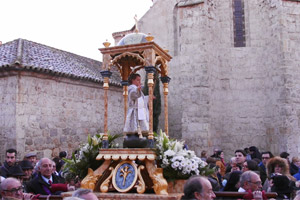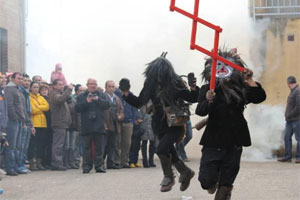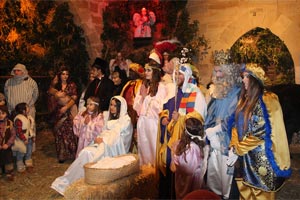La Orotava Patronal Festivities
Patron Saint Festivities in La Orotava
In La Orotava, the patron saint festivities are celebrated, which stand out for their fusion of religious elements, traditions, and local customs. These festivities, in honor of Corpus Christi, San Isidro Labrador, and Santa María de La Cabeza, have deeply rooted in the municipality, becoming a testimony to its history.
The most important celebration is the Infraoctava of Corpus Christi, which is considered the most prominent celebration in the Canary Islands and one of the most relevant in Spain. Its origin dates back to the 19th century. One of the most solemn moments is the creation of carpets made of natural flowers in the streets of the old town. That is why it is noteworthy that they have been declared national interest festivities.
The Romería is another important event, in which a procession of faithful carrying the images of the patron saints of the town, San Isidro and Santa María de la Cabeza, takes place. During the pilgrimage, symbolic fruits and lands are offered to them. The procession includes numerous carts and floats representing agricultural life, as well as musical groups that perform popular and folk songs.
The tradition of creating carpets began in 1847, with a Baroque-style geometric design using the cobblestones of the streets as a base. This idea was so astonishing that it quickly gained popularity, especially among the local aristocracy. Since then, the flower carpets have become the most famous tradition of La Orotava.
The carpets are a prominent artistic manifestation during these festivities. They are made with flowers and volcanic sands to celebrate Corpus Christi on its eighth day. The Carpetmakers Association is responsible for preserving and spreading this tradition today.
In summary, there are several festive events that take place around these dates, not only from the day Corpus Christi is celebrated but also in the days before. The festive program includes a rich range of activities that is recommended to consult each year. Highlighting:
The Corpus Christi festivity, celebrated on the Thursday following Corpus Sunday, followed by the traditional Baile de Magos of La Orotava. On Saturday, the exciting ascent of the saint takes place, also known as the "romería chica," accompanied by a livestock exhibition fair. And finally, on Sunday, the popular romería in honor of San Isidro Labrador and Santa María de la Cabeza is celebrated.
Corpus Christi in La Orotava
The Corpus Christi festivity, which has its roots in the year 1264, was established by Pope Urban IV to commemorate the miracle of the Eucharistic consecration. This celebration is anthropologically linked to the arrival of spring and the renewal of nature.
In the Canary Islands, the Corpus Christi festivity was established during the conquest period, and since then, all the localities of the archipelago celebrate it to honor the consecration of the Forms.
In La Orotava, this festivity has been celebrated since its inception as a settlement, but it gained renown starting in 1847 when members of the Monteverde family, inspired by Leonor del Castillo, created a flower carpet to adorn the passage of the Corpus' floats in front of their house.
The flower and volcanic sand carpets are one of the most representative artistic expressions of these festivities. These tapestries are made during the eighth day of Corpus Christi.
Currently, the Carpetmakers Association is responsible for preserving and spreading this tradition.
Romería of San Isidro Labrador
Throughout the second half of the 17th century, La Orotava has been celebrating the festivity of San Isidro. In the past, farmers used to celebrate it on May 15th at the hermitage of Nuestra Señora de la Piedad, located on the outskirts of the town. During the 17th century, this festivity began to be known as San Isidro Agrícola (San Isidro the Farmer).
Over time, this celebration has undergone many changes, transitioning from being a tribute from the farmers to their saint to being controlled by the aristocracy. The tradition of erecting arches and releasing balloons has been lost. Currently, the festivity takes place in the month of June, and the livestock fair and the pilgrimage are the events that attract the most people. It is worth mentioning that the carts are pulled by oxen, people dress in traditional "mago" costumes (peasant attire), and women decorate balconies and windows with carpets, tablecloths, and shawls.
Livestock Exhibition Fair and the Ascent of the Saint
On Saturday morning, the traditional Livestock Fair takes place, an event that combines tradition, folklore, and religiousness. It is not just a gathering and exhibition of animals, but also the blessing of fields and livestock. San Isidro Labrador and Santa María de la Cabeza, the patron saints, are carried in procession to their Sanctuary after the mass.
The "Romería Chica" (Little Pilgrimage), which precedes the Romería of San Isidro, is a celebration that gains strength each year in La Villa. On the eve of the big day, hundreds of residents accompany the Patron Saints from the Sanctuary of Calvary to the Parish of Nuestra Señora de La Concepción. This transfer, known as the "Ascent of the Saint," concludes with a fireworks display.
What to See in La Orotava
La Orotava has many attractions to visit. Here are some recommended places in the area and its surroundings:
- Historic center: Explore the charming streets of the old town of La Orotava, where you'll find manor houses, churches, and squares with a traditional atmosphere and colonial architecture.
- Church of La Concepción: Visit this beautiful 18th-century church located in the main square of La Orotava. Its baroque facade and decorated interior are impressive.
- Jardines del Marquesado de la Quinta Roja: Explore these lush gardens surrounding the Casa del Marqués de la Quinta Roja. Enjoy the beauty of the native flora of the Canary Islands and panoramic views.
- Museum of Ibero-American Crafts: Learn about the rich artisanal tradition of Ibero-America in this museum. Discover a wide collection of artisanal objects from different countries and cultures.
- Casa de los Balcones: Visit this historic house with carved wooden balconies, where you can appreciate the traditional craftsmanship of La Orotava and purchase local products such as embroidery and ceramics.
- Mirador Humboldt: Enjoy a panoramic view of La Orotava and its surroundings from this viewpoint. Observe the sea, the valley, and the majestic Teide, the highest peak in Spain.
- Teide National Park: Take advantage of La Orotava's proximity to Teide National Park and visit this impressive natural environment. Explore the trails, admire the volcanic landscapes, and take the cable car for spectacular views.
These are just some of the places you can visit in La Orotava. Don't forget to also explore its traditional restaurants, try the local cuisine, and immerse yourself in its rich culture and traditions.
Recommended Crafts and Shopping
In La Orotava, you will find a variety of crafts and local products that you can purchase as souvenirs or gifts. Some recommended crafts and shopping in La Orotava include:
- Embroidery: La Orotava is known for its beautiful embroidery. You can find hand-embroidered handkerchiefs, tablecloths, bed linens, and other decorative products with traditional designs.
- Ceramics: Explore the ceramic shops and discover unique handmade pieces such as vases, plates, cups, and tiles. La Orotava ceramics often feature designs inspired by local flora and fauna.
- Honey and bee products: The La Orotava area is known for its high-quality honey production. You can find a variety of local honey as well as related products like pollen, royal jelly, and propolis.
- Wines: The La Orotava region is also famous for its wines. Explore the local wineries and discover wines from the Denomination of Origin Valle de La Orotava, such as those made with the Listán Negro grape.
- Almond sweets: Almond sweets are very popular in La Orotava. Almond cakes, "polvorones," and marzipans are some of the typical sweets you can taste.
- Wood crafts: Look for carved wood products such as boxes, decorative figures, and small furniture. The skill of local artisans is reflected in these beautiful woodworks.
Remember to explore local shops and markets in La Orotava to find a wide selection of crafts and unique products. This will allow you to take a piece of the local culture and tradition with you as you enjoy your visit.
What to Eat in La Orotava
La Orotava offers a rich typical cuisine that reflects the tradition and flavors of the region. Here are some popular dishes and products:
- Papas arrugadas: "Papas arrugadas" (wrinkled potatoes) are an iconic dish in the Canary Islands and are also enjoyed in La Orotava. They are small potatoes boiled with their skins and salt, served with "mojo picón," a spicy sauce made from peppers, garlic, and spices.
- Conejo en salmorejo: "Conejo en salmorejo" (rabbit in salmorejo sauce) is another traditional dish in the area. It consists of rabbit meat marinated in a sauce made from garlic, paprika, vinegar, and spices, and then cooked slowly to achieve a tender and flavorful texture.
- Goat meat: Goat meat is highly appreciated in La Orotava. It is prepared in various ways, such as stewed or roasted, and is usually served with potatoes and "mojo" sauce.
- Goat cheese: La Orotava is known for its production of goat cheese. You can find local varieties of goat cheese, ranging from fresh and mild to aged and flavorful.
- Almond sweets: Almond sweets are very popular in La Orotava. Almond cakes, "polvorones," and marzipans are some of the typical sweets you can taste.
- Wines: La Orotava is located in a wine-growing region, so you must try the local wines. Wines from the Denomination of Origin Valle de La Orotava, mainly made with the Listán Negro grape, are highly appreciated.
In addition to these dishes and products, you can also enjoy tropical fruits such as mangoes and bananas, which are grown in the region.
Feel free to explore local restaurants and wineries to taste the delicious cuisine of La Orotava and discover the authentic flavors of the area.






